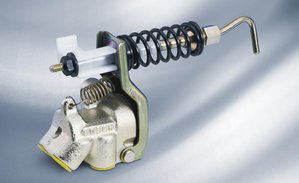Braking force regulator
When the brakes on a vehicle are applied, the vehicle weight shifts from the rear axle to the front axle. This is known as dynamic axle load transfer. The load on the rear wheels is relieved and their road grip is reduced...
Function
When the brakes on a vehicle are applied, the vehicle weight shifts from the rear axle to the front axle. This is known as dynamic axle load transfer.

The load on the rear wheels is relieved and their road grip is reduced. Too high a brake pressure at the rear axle can cause the rear wheels to lock. As a result they lose their cornering force and the entire vehicle may start to skid.
It is for this reason that braking force regulators, which reduce the brake pressure at the rear wheels, are used in brake systems.
Types of braking force regulators
Different types of braking force regulator are in use:
Braking force limiters
Braking force limiters only permit a specific set brake pressure to be exerted at the rear wheels. They are usually mounted directly on the master brake cylinder. Load-dependent braking force regulators Load-dependent braking force regulators are used in vehicles in which weight distribution varies significantly based on the number of occupants or the load. They control the brake pressure exerted at the rear wheels based on vehicle load. This prevents locking of the rear wheels and thus avoids the risk of skidding. In the case of vehicles with diagonal force braking distribution, either two separate braking force regulators or one regulator with two control units are required for the rear wheel brakes. Load-dependent twin regulators accommodate two identical control units which work independently and in parallel in a single housing. If one circuit fails, the brake circuit that remains intact can continue working unaffected.Electronic brake force distribution
Electronic brake systems feature integrated electronic brake force distribution as standard. The brake pressure on the rear wheels is limited as soon as a defined pressure is exceeded. No additional components are required in the brake circuit.Safety
Car drivers must be able to relay on 100% functioning of the brakes. Therefore, high quality must be of prime importance where the components of the brake are concerned. The use of braking force regulators enables maximum braking to be achieved. At the same time, the locking of the rear axle wheels and the dangerous skidding of the vehicle associated with this are avoided.
Depreciation
Braking force regulators from well-known suppliers feature the use of materials such as stainless steel and aluminium which afford reliable protection against corrosion, thereby safeguarding a long service life and optimum functionality.







